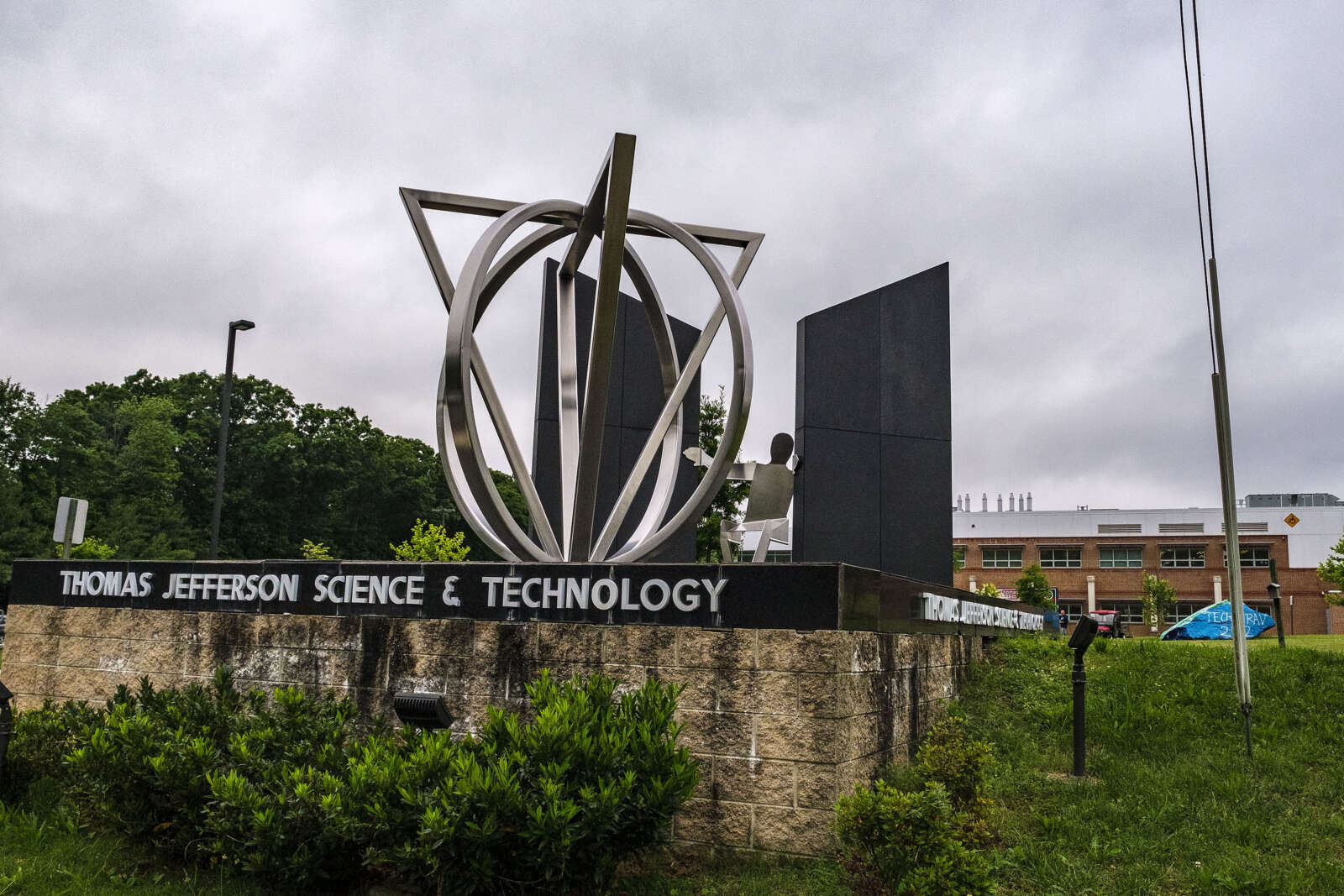
Thomas Jefferson High School for Science and Technology’s current admissions policy will remain in place after the U.S. Supreme Court declined to consider a lawsuit alleging that it discriminates against Asian students.
The Supreme Court denied a petition for a hearing today (Tuesday) by the Coalition for TJ, an advocacy group that sued the Fairfax County School Board in 2021 after the admissions process for the highly competitive magnet school was revised with the goal of diversifying the student body.
The Supreme Court’s decision not to take up the case ends a legal battle that lasted nearly three years and could’ve upended diversity initiatives in public education nationwide.
“We have long believed that the new admissions process is both constitutional and in the best interest of all of our students,” said School Board Chair Karl Frisch, who represents Providence District. “It guarantees that all qualified students from all neighborhoods in Fairfax County have a fair shot at attending this exceptional high school.”
The school board voted in December 2020 to eliminate a standardized test and application fee that were previously required for students seeking admittance into Thomas Jefferson High School (TJ). The board also raised the minimum grade point average for applicants, guaranteed eligibility to the top 1.5% of eighth graders at each middle school and added essay requirements and consideration of “experience factors” such as a student’s status as a recipient of free meals or involvement in special education.
Spurred by student activism after Fairfax County Public Schools reported that fewer than 10 Black students had been accepted in both 2019 and 2020, the policy overhaul has resulted in more diverse classes at TJ, particularly in terms of geography and income, since the changes took effect in 2021 for the Class of 2025.
Though Asian students got 61.6% of offers for the freshman class that entered last fall, compared to 19% for white students, 6.7% for Black students and 6% for Hispanic students, the Coalition for TJ has argued that the revised policy was designed to reduce the number of Asian students at the school, violating Constitutional protections against racial discrimination.
A district court judge agreed with the coalition in 2022 that Asian American students were “disproportionately harmed,” ordering FCPS to scrap the new admissions policy. However, that ruling was overturned last May by an appeals court panel that found the coalition had failed to prove that the school board “adopted its race-neutral policy with any discriminatory intent.”
The coalition petitioned the Supreme Court to pick up the case after the justices ruled in June 2023 that colleges can’t explicitly consider race as part of their admissions processes, ending decades of affirmative action programs intended to boost Black, Hispanic and other often underrepresented students.
Pacific Legal Foundation senior attorney Joshua Thompson, who represented the Coalition for TJ, says the Supreme Court “missed an important opportunity” to address admissions policies like the ones adopted for TJ that don’t explicitly consider race but still affect student demographics.
“Today, the American Dream was dealt a blow, but we remain committed to protecting the values of merit, equality, and justice,” Coalition for TJ co-founder Asra Nomani said in a statement. “…For the courageous families who have tirelessly fought for the principles that our nation holds dear, this decision is a setback but not a death blow to our commitment to the American Dream, which promises equal opportunity and justice for all.”
In a statement from FCPS, Frisch noted that TJ has accepted students from every Fairfax County middle school and maintained an average grade-point average for its incoming classes of 3.9 over the past three years.
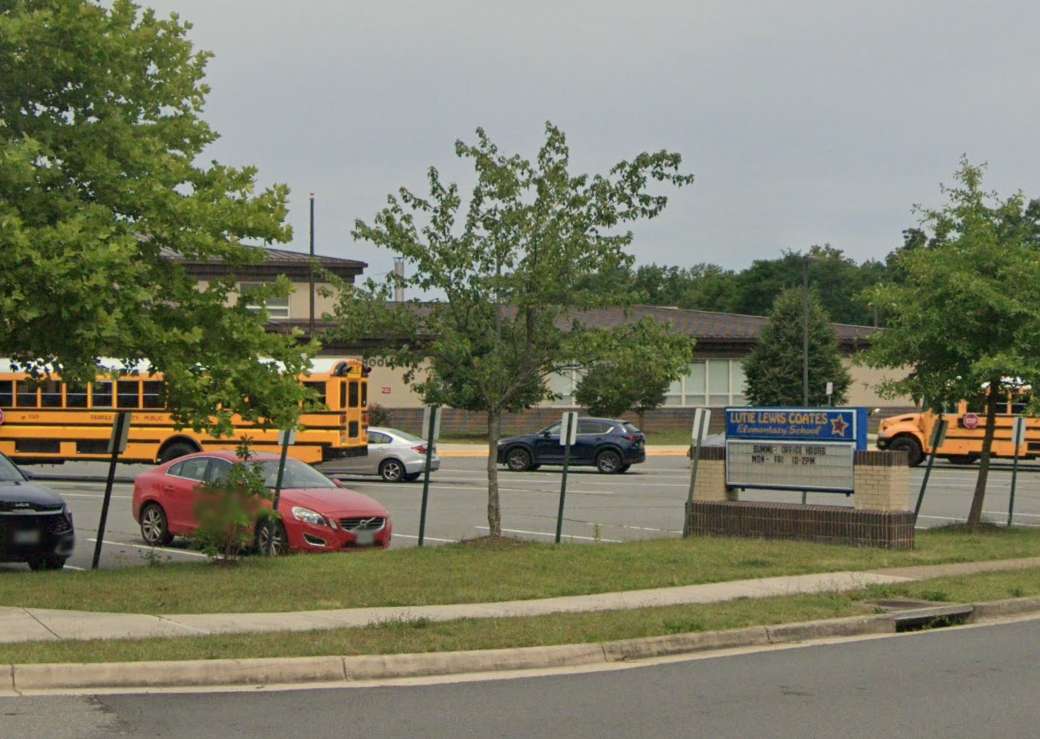
Fairfax County Public Schools is attempting to streamline its approach to managing capital projects to reduce costs and overcrowding in schools.
The school board approved a Capital Improvement Program (CIP) last Thursday, Feb. 8 for fiscal years 2025-2029 with multiple amendments intended to help lower costs, speed up select school renovations, meet green energy goals and enhance the process for tracking infrastructure projects.
The $1.3 billion, five-year plan allocates funding for the following projects:
- Construction of the planned Dunn Loring Elementary School
- A new wing to Justice High School
- Relocation of modular buildings
- Renovation of 18 elementary schools, two middle schools and two high schools
- Acquisition of land for one new high school
The revised CIP highlights a need to address overcrowding and capacity issues within the school system, with many schools nearing a critical tipping point.
Coates Elementary School in Herndon, for instance, is currently operating at 131% of its student capacity — a figure projected to rise to 172% by 2028. Crowding has been an issue for over 10 school years, according to the CIP.
At the moment, eight elementary schools, one middle school and eight high schools are operating beyond capacity, even though student enrollment has dipped from pre-pandemic levels and is expected to level out over the next five years.
Several other elementary schools, including Parklawn in Lincolnia, Mantua and Bailey’s, are expected to surpass student capacity in the coming years, per the capital plan. The same is true of Irving, Kilmer and Glasgow middle schools and Westfield, Centreville, McLean, Woodson, Robinson and Chantilly high schools.
The school board voted last week to add Coates and Parklawn as priorities for boundary adjustments, even as several members argued a more comprehensive approach to overcrowding issues is needed.
Parklawn is 96% capacity right now, but it’s projected to reach 112% by the 2028-2029 school year. It will still trail McLean’s Kent Gardens Elementary School, which will be at 113% capacity even after boundary adjustments were approved last year.
“The problem that I see, while we’re fixing these two tonight, if we don’t fix the process and fix other schools, we’re going to have Coates and Parklawns popping up like hotcakes across Fairfax County, and I don’t want to be in that position,” At-Large School Board Representative Kyle McDaniel said.
The board tasked Superintendent Dr. Michelle Reid with formulating a “facility infrastructure policy” and establishing a system to track projects to be presented to the board later this year.
“I see an eagerness on this board, which I’m very excited about, to really look holistically and comprehensively at our infrastructure needs, our funding, and really get sort of our hands wrapped around the policies that relate to infrastructure, but also an overarching policy that guides our decisions regarding infrastructure,” Mason District School Board Representative Ricardy Anderson said.
Board members also asked Reid to propose options for funding capital projects.
Hunter Mill District Representative Melanie Meren expressed an interest in initiatives such as “swing spaces” — pre-existing facilities that students and staff can temporarily relocate to during construction.
“The benefit of that is that renovations could go quicker, which means they could also cost less money,” she said.
Over in neighboring Arlington County, a plan to turn an elementary school into a swing space got nixed last year after an outcry by current and future parents.
Reid is expected to present cost-saving options and the facility infrastructure policy to the school board on April 25. Additionally, she is scheduled to submit a plan for tracking infrastructure projects on May 7.
Image via Google Maps

Fairfax County Public Schools is stepping up its requests for funding this year from both local and state leaders.
The school system is seeking an additional $254 million from Fairfax County for fiscal year 2025 — about 10.5% more than last year — to help fund a projected $301.8 million, or 8.6%, budget increase, FCPS Superintendent Dr. Michelle Reid reported in a presentation to the school board on Thursday (Feb. 8).
According to Reid, the increase is necessary for FCPS to meet the needs of all its students and adequately compensate its staff, even though student enrollment remains below pre-pandemic levels and no new initiatives are included in the proposed $3.8 billion budget.
With the county government bracing for a tight budget year itself, Reid stressed that the local request could be reduced if Virginia contributes more than the $42.2 million increase currently expected based on Gov. Glenn Youngkin’s proposed funding plan for the state.
“What I’m presenting…is what I believe we need to resource and sustain the excellent work that our staff are doing today and compensate our staff into the future to keep us competitive, with the hope that as our General Assembly deliberates…they’ll see the necessity of actually allocating a greater amount of state funding, which will help us out in terms of our county transfer,” Reid told the school board.
The disparity between the local and state funding for public education has long frustrated both county and FCPS leaders, who argue that the formula used to calculate funding needs for each school division is outdated and shortchanges Fairfax County — one of the wealthiest counties in the Commonwealth, but also its biggest and most populous.
Those grievances got validated last year when the Joint Legislative Audit and Review Commission released an anticipated study that found Virginia spends about $1,900 less per student than the national average, falling below nearby states like Maryland, West Virginia and Kentucky.
If the Commonwealth matched the 50-state average, it would allocate $345 million to FCPS, according to Reid.
“So, just funding us at the average would be more than what we’re actually asking for in additional funds,” she said.
Multiple school board members acknowledged that the size of the funding request may give some community members pause, especially with only a modest growth in enrollment projected for FY 2025, which starts on July 1.
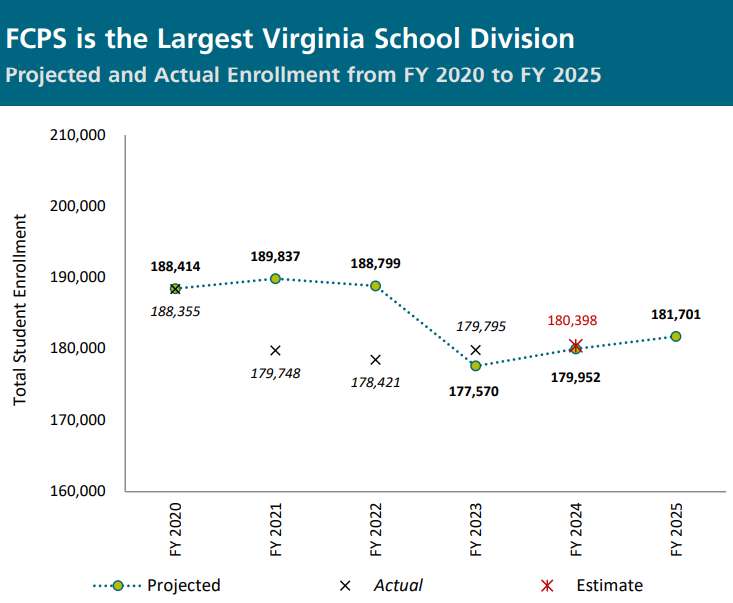
According to the proposed budget, FCPS expects to have 181,701 students next school year. Enrollment has ticked up over the past few years, reaching an estimated 180,398 students this year, but before the COVID-19 pandemic shuttered classrooms in March 2020, the school system had over 188,000 students. Read More
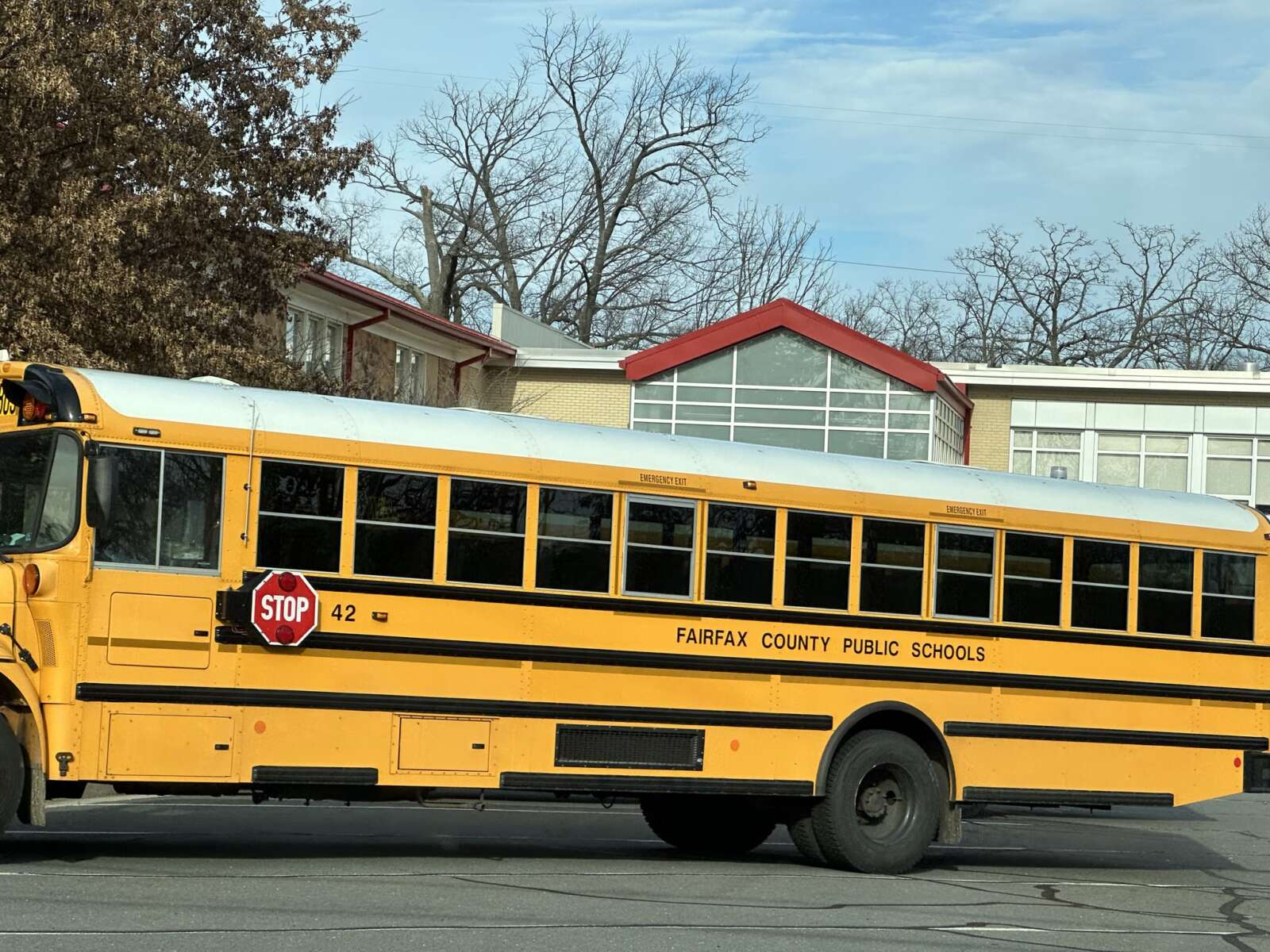
Teacher recruitment, school safety and controlling class sizes have been designated as top priorities for funding by the newly sworn-in Fairfax County School Board.
However, the county’s expected financial constraints may make it challenging for the board’s entire wish list to get funded in the upcoming budget cycle, which will start July 1.
Last week, the school board approved a resolution to serve as a guide for Fairfax County Public Schools Superintendent Dr. Michelle Reid as she crafts the school system’s proposed fiscal year 2025 budget.
The resolution highlights improving teacher compensation, particularly for special education and Title 1 schools, as a key priority. Board members also stressed the importance of increasing access to universal breakfast and lunch programs, reducing school meal debt, expanding preschool options, lowering class sizes, and providing additional funding for mental health and academic support.
While some of those priorities are broad in scope, Mason District School Board Representative Ricardy Anderson noted the board has been discussing these issues with the superintendent and her staff in both public and private meetings for months.
“This is not a surprise,” she said. “They have been part of these conversations, and they understand what the board finds important.”
Aside from Anderson, Braddock District Representative Rachna Sizemore Heizer, and Hunter Mill District Representative Melanie Meren, who supported the resolution, most school board members are newcomers who were not part of the initial discussions on the board’s budget priorities last year.
Despite that, Anderson noted that the new members — all elected in November with Democratic endorsements — have shown strong support for many of the same issues as the previous board, which was similarly all Democratic.
“There was a lot of overlap with what the former board found important and with what the new board finds important,” she said.
Still, there is the hurdle of getting the county on board.
Fairfax County staff told the school board and the Board of Supervisors at a joint meeting last November to prepare for a tough budget year, forecasting a $284.5 million shortfall mainly due to a “flat real estate market,” according to the county website.
At a Nov. 14 school board work session, FCPS Chief Financial Officer Leigh Burden predicted a $202.6 million gap in the revenue needed to fund a 6% salary increase for all FCPS employees, address rising student service demands, and cover inflationary costs.
FCPS has a total operating budget for the current fiscal year of $3.5 billion — a $221.7 million increase from the previous cycle.
The superintendent is set to present her budget proposal to the school board next Tuesday, Feb. 6. How her office will address the revenue gap and incorporate the school board’s priorities into the proposal remains unclear.
However, Anderson said she doesn’t anticipate the school board’s entire wish list will be fulfilled.
“They’re big ticket items, and there’s only so much you can do in any given year,” she said.
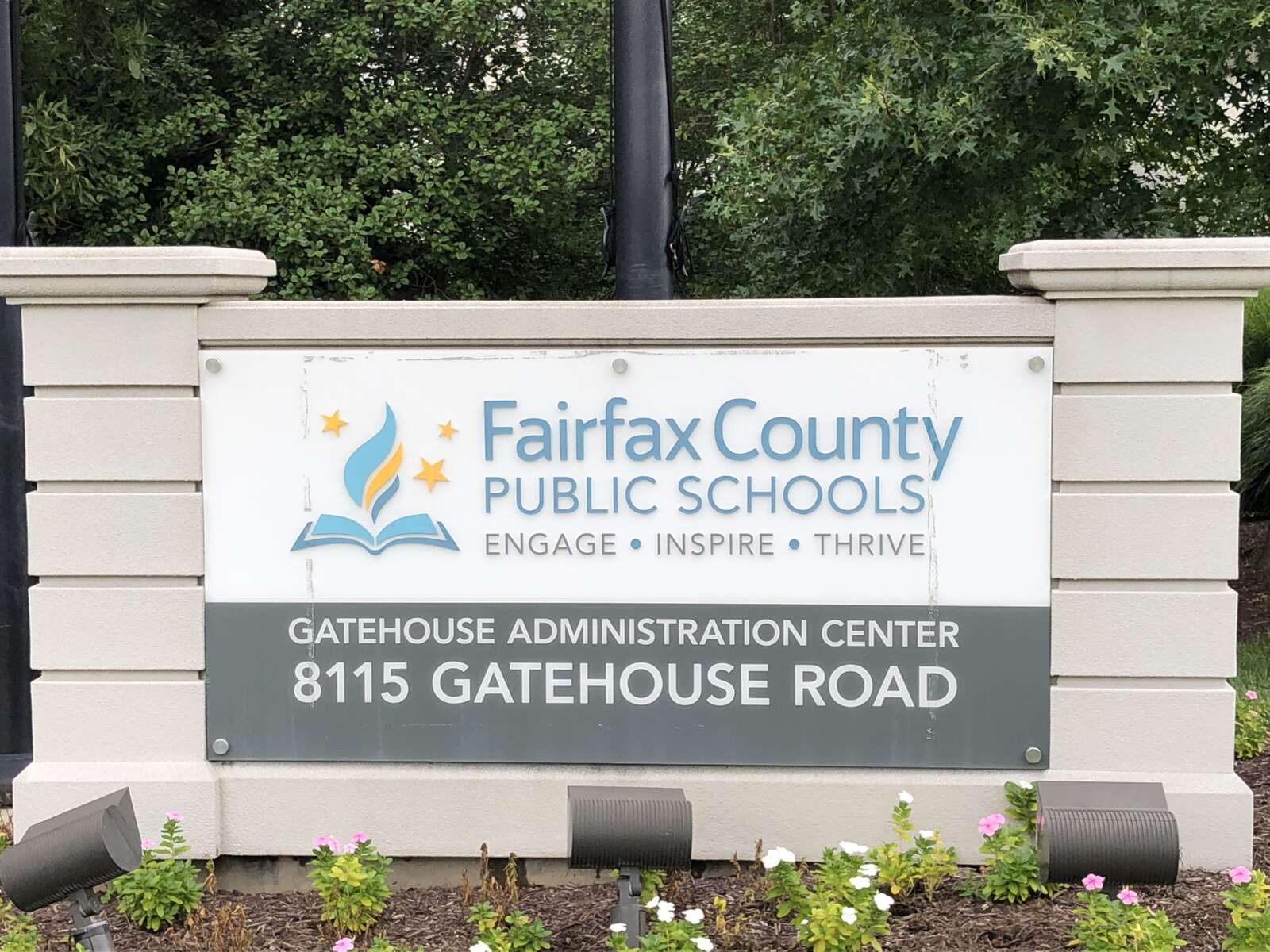
The upcoming capital projects plan for Fairfax County Public Schools comes with questions and uncertainties about future planning to address overcrowding and school capacity issues throughout the school system earlier this month.
Unveiled earlier this month, the new Capital Improvements Program (CIP) covers fiscal years 2025 through 2029. It sets the location, timing and funding of new schools, renovations and other capital projects over a five-year period.
At a Fairfax County School Board work session on Jan. 9, staff shared that the CIP accounts for cost increasesassociated with inflation, labor and materials increases, and prevailing wage.
Mason District Representative Ricardy Anderson pressed staff for answers how when schools in her district — namely Weyanoke Elementary School, Belvedere Elementary School and Luther Jackson Middle School — will be slated for renovation.
“Their buildings are highly problematic,” Anderson said.
Janice Szymanski, the school system’s chief of facility services and capital programs, a newly created position, said staff are working on building consensus on the renovation queue, which was last updated in 2009. The new line-up that’s currently under development isn’t reflected in the CIP at the moment.
FCPS Superintendent Michelle Reid also acknowledged that the renovation process has become “a bit muddled over time,” raising the need for the new queue.
“We don’t intend to be weasely as staff, but I do think we’re building the process while we take the input, so I want to manage expectations,” Reid said.
Major projects within the next five years include construction of Dunn Loring Elementary School, capacity improvements at Justice High School and the renovation of 22 schools.
The 10-year plan projects new construction of a Silver Line elementary school and a western high school, Pinewood Lakes Early Childhood Center, Tysons Elementary School, Pimmit Hills, and Virginia Hills.
Seema Dixit, the board’s new Sully District member, said she was especially concerned about overcrowding issues on the western side of the county.
“That’s where we have to put our brains together and find some creative ways,” Dixit said, noting that land acquisition for some schools is coming far too late.
Staff hope to lay out a new renovation queue that will establish how renovations — major and minor — are planned. The current renovation line-up has funding for planning, design or construction projects through 2031.
So far, a consultant worked with stakeholders in early 2023 to create possible criteria for new facilities. Phase two of the update includes compiling data and reviewing a new queue. The final phase of the project would incorporate the new system into the annual CIP and future bond referenda.
School board members also lamented a lack of sufficient progress on pursuing net-zero energy goals. Solar power purchase agreements are in place for Annandale High School and Mason Crest Elementary School.
At-large board member Ryan McElveen said he was particularly dismayed about limited progress on ensuring schools are ready for solar power, adding that he and fellow returning at-large member Ilryong Moon developed a list of 90 schools that were on track for being solar ready when they left the board in 2019.
“That is a major blow. Obviously there are reasons for all of this and this is not just an FCPS problem. This is a county problem as well,” McElveen said, referencing the challenges that the county government has faced in implementing solar projects.
Overall, total student membership is expected to remain flat over the next five years. The county’s demographic report also projects a decline in the school-aged population through next year.
School board action on the budget is expected on Feb. 8, followed by official release of the final CIP in mid-February. A public hearing was held on Jan. 18.
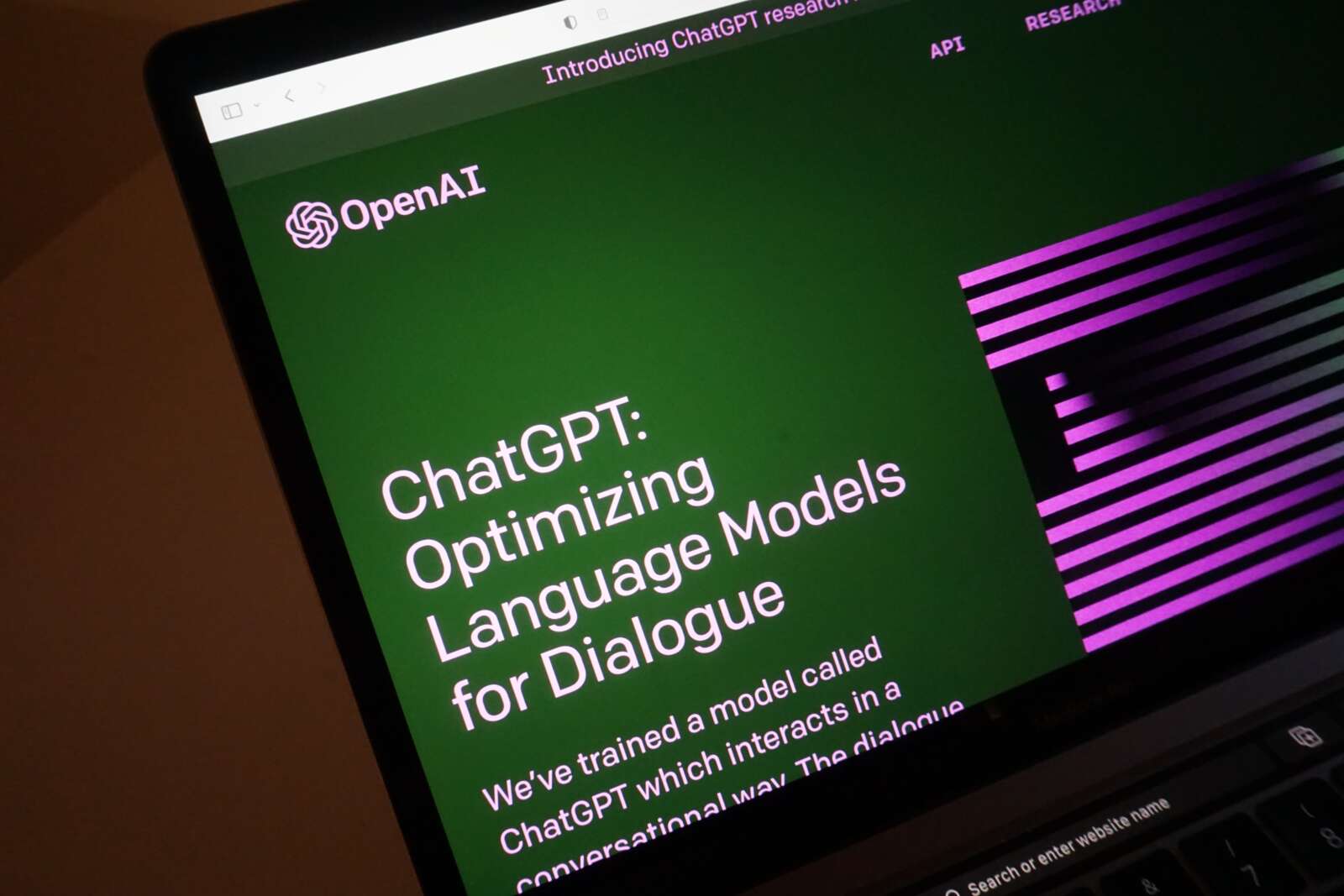
With ChatGPT and other artificial intelligence-based tools becoming increasingly mainstream, Fairfax County Public Schools officials have started discussing potential guidelines to govern how the technology is used in the classroom.
The Fairfax County School Board broached the topic at work session forum on Nov. 28, led by outgoing board chair and Dranesville District representative Elaine Tholen and Sully District representative Stella Pekarsky.
While the discussion wasn’t recorded, Tholen says the school board felt it was a way to make the public aware that FCPS is developing a strategy for how it will handle AI, which is getting integrated into industries from public safety and health care to filmmaking.
“The School Board and FCPS recognizes that a comprehensive AI strategy is crucial for preparing students and educators for the future, enhancing the learning experience, and ensuring the school division remains competitive and adaptive in the rapidly evolving educational landscape,” Tholen said.
AI has been utilized for educational purposes for years, as apps like Duolingo and iNaturalist rely on algorithms that allow them to process data, identify patterns and adapt. But the recent advent of generative AI — which can create text, images and sound based on that data, with OpenAI’s ChatGPT and DALL-E as two high-profile examples — has raised new practical, legal and ethical questions.
In response to fears that students will use AI to cheat or do their homework, New York City Public Schools, Los Angeles Unified and other school districts have banned ChatGPT from their networks, while elsewhere, teachers suggest it could be a useful tool if handled responsibly.
The Highlander, McLean High School’s student newspaper, found that many students have at least experimented with AI, with 40% of 223 surveyed students admitting to utilizing it for at least one school assignment.
Fairfax County Federation of Teachers President David Walrod says the union’s members haven’t raised a lot of concerns about students using ChatGPT, but he’s aware that there are concerns “from teachers more generally across the country.”
“I do think it will require a change to some teaching practices, but I also see potential for positive change,” he told FFXnow.
In addition to using tools that can identify AI, similar to ones used to detect plagiarism, teachers may have to adjust what kinds of assignments they ask students to do at home versus in school, Walrod says. They could also put more emphasis on tasks that require students to show their work, such as an outline, graphic organizer or even a handwritten first draft for an essay.
While the technology presents challenges, it could help teachers by reducing or streamlining their workload. As examples, Walrod shared a hypothetical math lesson plan and discussion questions on the children’s novel “Bud, Not Buddy” generated by ChatGPT, noting that they could serve as “an effective starting point.”
“This doesn’t do all the work for me; I still need to generate examples, I need to find the materials to distribute, etc,” Walrod said by email regarding the math lesson plan. “But it does give me a general outline to follow and allows me to focus on preparing and creating the materials.” Read More
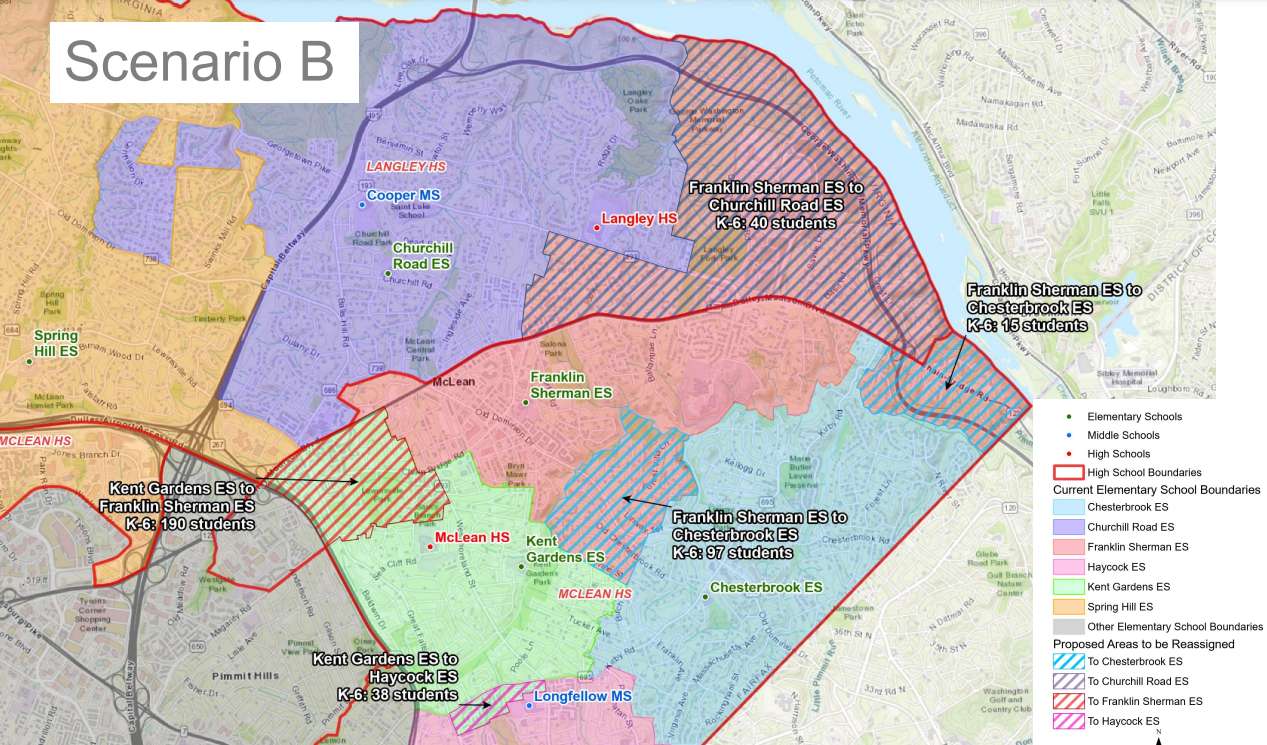
Kent Gardens Elementary School should finally get some substantial capacity relief, starting next school year.
The Fairfax County School Board approved tweaks to the boundaries of five elementary schools in McLean on Monday (Dec. 4) with the goal of alleviating crowded conditions at Kent Gardens (1717 Melbourne Drive), which was at 121% of its programming capacity, as of the 2022-2023 school year.
When it takes effect with the 2024-2025 school year, the approved plan will shift 190 students to Franklin Sherman Elementary School and 38 students to Haycock Elementary School, according to Fairfax County Public Schools. To avoid creating capacity issues at Franklin Sherman, 112 of its students have been reassigned to Chesterbrook Elementary School and another 40 to Churchill Road Elementary.
One of six scenarios suggested by FCPS staff, the adopted proposal also adjusted the boundaries for Advanced Academic Placement (AAP) centers at Churchill Road and Haycock.
In total, an estimated 380 elementary school students will be affected, but no impact is expected at the middle or high school levels.
“When boundary adjustments are necessary, it is vital that our school communities join us in the process,” School Board Chair and Dranesville representative Elaine Tholen said in a statement that thanked families, students and other community members who participated in the boundary study, which has been in the works since fall 2022.
“It is through a combination of your input and staff expertise that we are able to provide a solution that best meets the needs of our students,” she added.
Before the school board’s vote, Tholen acknowledged that the changes will have a “significant” impact on Franklin Sherman, but the “realities of the geography” made the chosen scenario the best option.
“It was hard to move students from the eastern side of the attendance area to Chesterbrook, since most of those students are walkers,” she explained. “Transportation [staff] specifically requested we not move any walkers due to the shortage of bus drivers.”
While community members generally recognized the boundary adjustment as necessary at a Nov. 30 public hearing, some raised concerns about moving students out of a familiar environment where they’ve established friends and separating siblings.
One speaker observed that Stoneleigh and Hallcrest Heights, the biggest multi-family and townhouse communities currently served by Kent Gardens, are being reassigned to Franklin Sherman. Read More

(Updated at 11:25 a.m.) The Fairfax County School Board will vote next week on $847,000 in funding for security cameras at nine elementary schools.
That project is among those that could be funded as part of Fairfax County Public Schools’ midyear budget review, which Chief Financial Officer Leigh Burden presented to the board on Monday (Dec. 4).
FCPS has also proposed allocating $100,000 to cover costs associated with renaming Woodson High School after Carter G. Woodson. The change from former FCPS superintendent W.T. Woodson was approved on Nov. 9 and will take effect with the 2024-2025 school year.
“Historically, renaming costs have typically been about $300,000, but many items at Woodson just say ‘Woodson,’ so those items will not have to be replaced,” Burden said.
The board-authorized funding for security cameras would supplement money the county has received from two Virginia Department of Education grants to fund security cameras at eight elementary schools.
“Prioritization is determined by the building age, the number of existing cameras, the number of incidents at a school location as well as access to uninterrupted power,” Burden said in her presentation.
The elementary schools slated to receive funding through the mid-year budget review are Deer Park, Coates, Springfield Estates, Bull Run, Terra Centre, Greenbriar East, Freedom Hill, Bush Hill and Graham Road.
Another eight schools — Pine Spring, Great Falls, Fort Hunt, Sunrise Valley, Newington Forest, Rose Hill, Forest Edge and Glen Forest — will get cameras through the VDOE grants, which had different criteria for each application, according to an FCPS spokesperson.
When selecting the schools, FCPS considered factors such as the number of students eligible for free and reduced meals, the number of incidents at a given school, when the school was built, the availability of uninterrupted power and how many other schools in each region already had security cameras, the spokesperson told FFXnow.
Superintendent Michelle Reid told the school board in May that about half of the elementary schools in FCPS had exterior video cameras, along with all high schools. Installations at all middle schools were expected to finish this year, and she hoped to expand the program to all elementary schools in the “near future.”
Overall, FCPS has just over $6.1 million in additional funding to allocate in its mid-year budget review, most of which comes from higher-than-anticipated sales tax revenue identified after the end of fiscal year 2023, according to Burden. About $1 million comes from federal Individuals with Disabilities Education Act grants, which support the school operating fund, she said.
The mid-year budget review also includes $88,000 to support restorative justice interventions and $80,000 for improvements to power sources used for Advanced Placement digital testing at select high schools. About $3.1 million would be held for fiscal year 2025, which starts on July 1, 2024.
“We generally like to try to keep the beginning balance around the same level as it is in the previous year because otherwise, if it’s less than that, then that just increases the local request to the county,” Burden said.
Braddock District Representative Megan McLaughlin asked about funding for school maintenance and repairs. She suggested Reid confer with Janice Szymanski, chief of facilities services and capital programs, and her team about addressing some “backlog maintenance issues” ahead of the board’s vote on Dec. 14.
“We just keep telling our communities, in particular our athletic boosters that work hard, tirelessly, year after year to bring money to the table, and then to get told, ‘We’re sorry we promised you that repair project, but there’s no money dedicated to it,’” McLaughlin said. “I think we’re losing faith and support and confidence from our families when we make promises and then we don’t deliver.”
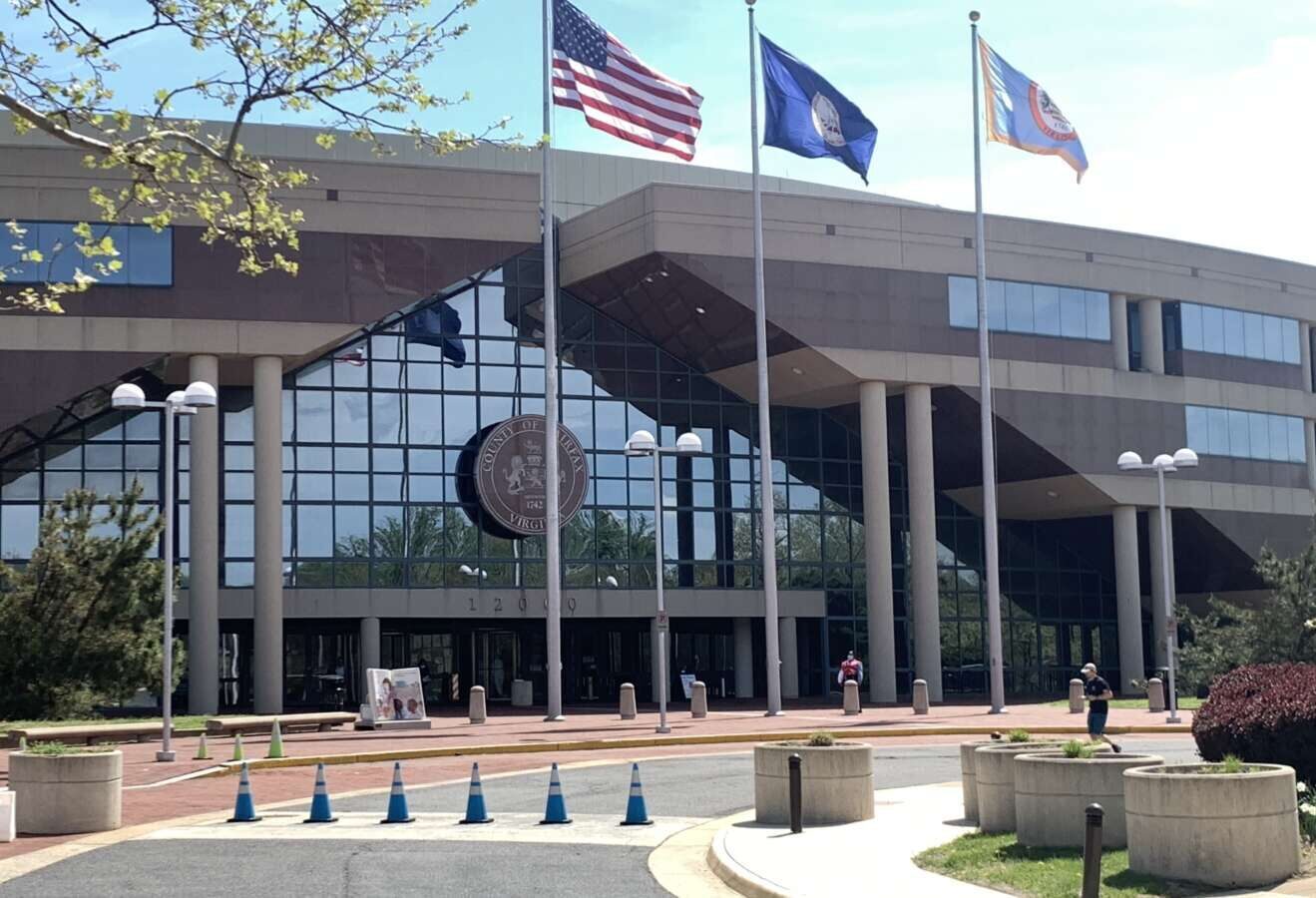
Anticipating slow growth in the real estate tax base and only a modest increase in general fund revenues, local officials are preparing for a slim budget in the next fiscal year.
At a joint meeting on Tuesday (Nov. 28), the Fairfax County Board of Supervisors and the school board got an early forecast of projected revenues, expenditures and general priorities for the county government and public school system’s fiscal year 2025 budgets.
Christina Jackson, the county’s chief financial officer, emphasized that the forecast is an early estimate of the budget.
“We recognize that this was going to be a challenging year,” said Jackson.
County officials anticipate a combined net budgetary shortfall of $284.5 million.
Based on last month’s projections, non-residential tax revenue is expected to grow by 1.9% from the current fiscal year 2024 rate of 3.6%. In fiscal year 2023, non-residential tax revenue stood at 7.3%.
That’s coupled with substantially lower growth in the real estate tax base for next year — a mere 1.7% compared to 6.6% in the current fiscal year. The residential real estate market has softened as a result of high mortgage rates, but values are still expected to increase by 2.1% due to low supply, county staff said.
Funding conversations continue in the background of a study that found Virginia’s school divisions receive 14% less funding from the state than the average for all 50 states.
Calling the state’s underfunding “a generational wrong,” McKay said the report by the Joint Legislative Audit and Review Commission (JLARC) is a critical opportunity to shift the statewide conversation about the state’s funding formulas.
“This study can either collect dust and be ignored, or this study can be acted on and Virginia can get ahead of West Virginia and Kentucky, which frankly should embarrass everyone who lives in Virginia,” McKay said.
Ricardy Anderson, who represents Mason District on the school board and chairs the board’s budget committee, highlighted the space constraints that Fairfax County Public Schools already faces.
“We cannot trailer our way out of this issue, because the schools are growing,” she said, noting that at one school, the entire fifth grade is housed in trailers.
She suggested that the county restart a conversation about adopting a meals tax in order to generate revenue. County voters rejected a referendum in 2016, but the General Assembly approved a bill in 2020 that gave counties the authority to tax food and beverages without a referendum. Read More

A proposal to ease overcrowding at Kent Gardens Elementary School will require adjustments at four other elementary schools in McLean, but local middle and high schools have been spared.
The Fairfax County School Board will hold a public hearing at 6 p.m. this Thursday (Nov. 30) to get community feedback on the recommended boundary changes, which will affect an estimated 380 students, according to Fairfax County Public Schools.
A presentation on the proposal was expected on Nov. 20, but the school board’s meeting that day got canceled. Elaine Tholen, who represents the Dranesville District on the board, confirmed that the public hearing and a final vote on Dec. 4 will proceed as scheduled.
As of October, there were 1,006 students enrolled in Kent Gardens (1717 Melbourne Drive) — a decline from the 1,023 students enrolled during the 2022-2023 school year, according to FCPS. However, the school remains well above capacity in terms of both its design (896 students) and its programming (848 students).
After years of complaints about overstuffed schools from the McLean community, the school board designated a boundary adjustment for Kent Gardens as a priority in the fiscal year 2024-2028 capital improvement plan adopted earlier this year.
Chosen out of five options presented to the community in September, the change recommended by FCPS staff would reassign 190 students from Kent Gardens to Franklin Sherman Elementary School, which is currently utilizing just 77% of its program capacity. Another 38 students would move to Haycock Elementary.
The proposal would also shift 112 Franklin Sherman students to Chesterbrook Elementary School and 40 students to Churchill Road Elementary.
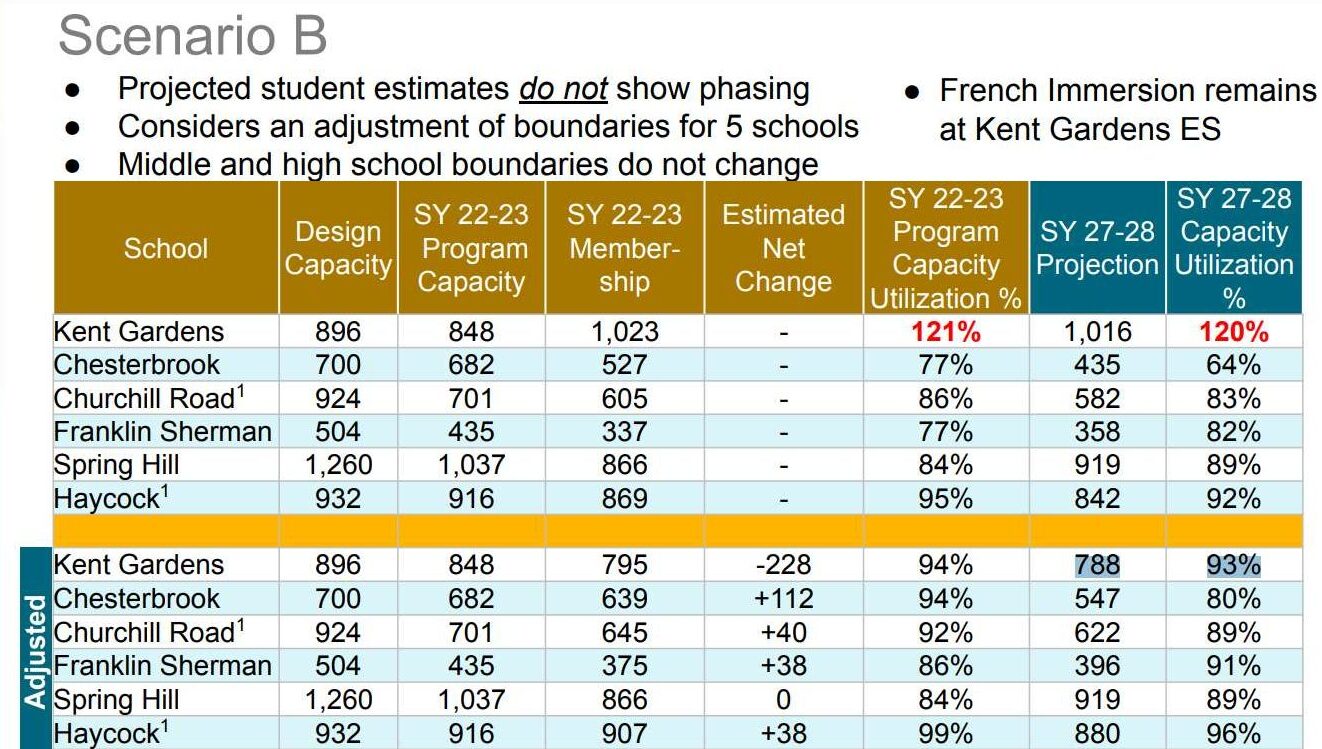
On its webpage for the boundary adjustment, FCPS says this scenario “balances student population and capacity of schools in the area,” while considering potential development in McLean that could have a future impact on local elementary schools. Read More

